Kawasaki produces some of the fastest and most reliable jet skis in the world. The Kawasaki X2 was one of those top jet skis and still provides a great ride. In this article, we’ll list all of the essential Kawasaki X2 Jet Ski specs and features so you can decide if it is the right jet ski for you.
The Kawasaki X2 Jet Ski, first introduced in 1986, has a lean-in “sports” design that can accommodate two people with ease. The X2 is powered by a 650 cc gasoline engine. Later on, Kawasaki introduced other variants of the X2, each with its own distinct name.
The X2 models have the same motor and pump as three other Kawasaki jet skis, namely the Jetmate, the TS650, and the JS650. Later in 2006, Kawasaki re-launched the X2.
This new iteration has a completely redesigned top deck and hull but uses the same motor and pumps, the most popular standard model.
Read on to learn more about the Kawasaki X2 specs and how they compare with their nearest competitors.
About the Kawasaki X2 Jet Ski

Kawasaki X2, a Jetski model with a 650 cc gasoline engine, was introduced by Kawasaki in 1986. At first, this X2 was designed to accommodate two-person.
Later on, Kawasaki introduced other variants of the X2, each with its own distinct name.
Almost everyone knows what a jet ski is. However, they assume that it is a generic name for personal watercraft. That is a wrong assumption since it is a name coined by the Kawasaki Heavy Industries to brand their own PWCs.
In other words, when you speak about jet skis, you are technically referring to Kawasaki PWCs.
But just like what happened to Colgate for toothpaste and Kodak for cameras, jet skis became the ‘generic’ name of PWCs. Therefore, it is correct to state that Kawasaki started the craze for speed machines on the water.
In 1986, Kawasaki introduced a two-person Jet Ski model and named it Kawasaki X2. It has a 650 cc engine and designed with a lean-in “sport” style handling.
Over the succeeding years, Kawasaki would come out with other models of the Kawasaki X2:
- 800SXR
- Ultra 250/260
- SXR 1500
In celebration of the 30th anniversary of its Jet Ski brand, Kawasaki released a special edition of the SXR in 2003. The company also updated the X2, based it on the SX-R platform, and re-launched it in Japan.
According to Kawasaki X2 review, Kawasaki’s jet skis are some of the fastest in the world. They are also reliable and can be modified according to the whims and wishes of their owners.
Kawasaki 800 SXR Specs and Features
Engine and Drivetrain
The Kawasaki 800 SXR is a one-passenger stand-up jet ski. It is powered by an in-line, 2-cylinder two-stroke gasoline engine with a brake horsepower of 80 hp (59.7 kW) at 6,250 revolutions per minute.
The gasoline engine has a displacement of 781 cubic centimeters (47.4 cubic inches) and a compression ratio of 7:2:1. It is also electric starting.
Finally, this engine is carburetor type with the Mikuni brand installed. There are two carburetors, each measuring 40 millimeters.
Drive Line
This Jet Ski driveline is jet pump type – axial flow with a stainless steel impeller with 3 blades.
Transmission
The transmission type of the Kawasaki 800 SXR is direct drive, finger throttle type with no reverse.
Steering
The steering type of this Jet Ski is manual steering. Thus, there is no steering assist system. In fact, its steering control is a handle pole, and tilt steering is standard in this model.
Fuel Capacity
The Kawasaki 800 SXR uses gasoline and oil premix fuel. Regular gasoline is used. Lastly, a full tank is equivalent to 5 gallons or 18.0 liters of gasoline.
Dimensions
The Kawasaki 800 SXR has the following dimensions:
- Length – 7.55 feet
- Width – 28.7 inches (729 millimeters)
- Height – 28.9 in. (734.1 mm.)
- Dry Weight – 351 lbs. (159.2 kg.)
- Engine Displacement to Weight – 2.23 cc.
Convenience
The Kawasaki 800 SXR has adjustable handlebars as standard. Its bilge system type is an automatic siphon.
Body
The body and the hull of the Kawasaki 800 SXR are made of fiberglass reinforced plastic (FRP). Moreover, it is skid-resistant. Handgrips are also standard.
Top Speed
The maximum speed of a stock Kawasaki 800 SXR is 48 miles per hour (mph). But 800 SXR owners have modified their engines to reach top speeds ranging from 60 to 70 mph.
Below is an excellent Kawasaki XR review (800 SXR) showing some of its important specs features. The 800 SXR is a great personal watercraft for racers and even casual riders:
Pros and Cons of the Kawasaki 800 SXR
Pros
- One of the advantages of the Kawasaki 800 SXR over its nearest rivals is its lower weight. Consequently, less weight equates to less fuel consumption and faster acceleration;
- This Jet Ski has smaller dimensions compared to its competitors. That means it needs less storage space. It even fits on the bed of a standard pickup truck; and
- It also offers more flexibility to the rider. This Jet Ski allows riders to do tricks easier and enables them to enjoy a more playful ride.
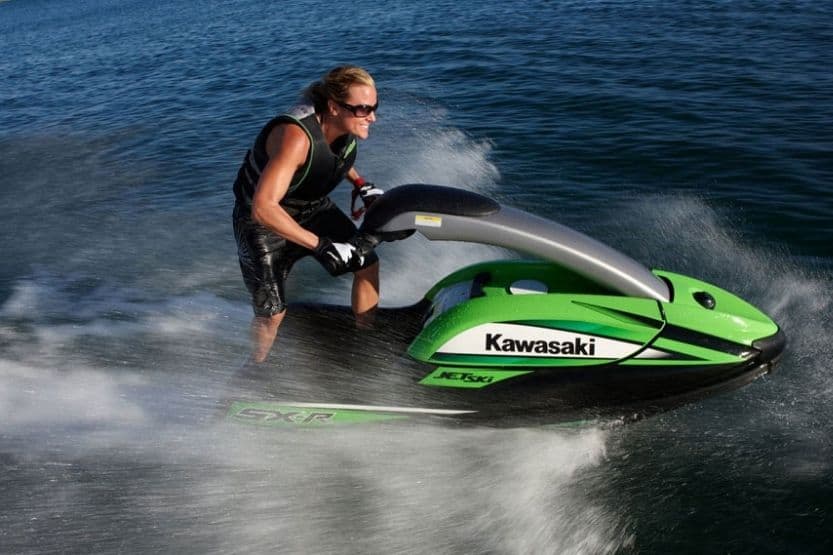
Cons
- This jet ski is a bit difficult to re-board from deep water;
- It is less stable;
- A 2-stroke engine is less durable, has more restrictions, and consumes more fuel; and
- Its top speed is slower than its rivals.
Kawasaki 800 SXR Value
The retail price of the Kawasaki 800 SXR is $6,049.00. The Kawasaki 800 SXR has a 12-month warranty against factory defects.
Comparison Between the Kawasaki 800 SXR and Its Rivals
There are three rivals of the Kawasaki 800 SXR that compete in the same market:
- Honda
- Yamaha
- Sea-Doo personal watercraft.
The following is a comparison table between the Kawasaki 800 SXR, the Yamaha Wave Runner, and the Honda Aqua-Trax. The Sea-Doo PWC is omitted here because it has no model close to the other three specs and features:
| Specs and Features | 2008 Kawasaki 800 SXR | 2021 Yamaha Wave Runner Superjet | 2007 Honda Aqua-Trax R-12 X |
| Model Type | 1- passenger standup | 1- passenger standup | 2-Passenger |
| Price | $6,049 | $9,499 | $ 10,749 |
| Warranty | 12 months | 12 months | 12 months |
| Engine | |||
| Carburetion Type | Carburetor | Fuel Injected | Fuel Injected |
| No. of Cylinders | 2 | 3 | 4 |
| Engine Stroke | 2-stroke | 3-stroke | 4-stroke |
| Displacement (cc/ci) | 781 cc/47.7 ci | 1049 cc/64 ci | 1235 / 75.4 |
| Engine Type | In-line | In-line | In-line |
| Horsepower | 80 hp. | 100 hp. | 165 hp. |
| Steering Assist System | No | Yes | Yes |
| Top Speed | 48 miles per hour | 54 mph | 75 mph |
| Technical Specs | |||
| Dry Weight (kg/lbs.) | 159.2/351 | 170.1/375 | 338.4 / 746 |
| Fuel Capacity (gal/l) | 5/18.9 | 5/18.9 | 16.6 / 62.8 |
| Height (in/mm) | 28.9 / 734.1 | 31.1 / 789.9 | 40.8 / 1036.3 |
| Length (in/mm/ft.) | 90.6 / 2301.2.7 | 95.7 / 2430.8/11.7 | 120.5 / 3060.7 |
| Width (in/mm) | 28.7 / 729 | 30 / 762 | 45.7 / 1160.8 |
| Exterior | |||
| Body Material | Fiberglass Reinforced Plastic (FRP) Sheet Molded Compound | Fiberglass Reinforced Plastic (FRP) Sheet Molded Compound | Fiberglass Reinforced Plastic (FRP) |
| Hull Material | Fiberglass Reinforced Plastic (FRP) Sheet Molded Compound | Fiberglass Reinforced Plastic (FRP) Sheet Molded Compound | Fiberglass Reinforced Plastic (FRP) |
| Convenience | |||
| Bilge System Type | Automatic Siphon | Automatic Siphon | Automatic Siphon |
Features
The 2007 Honda Aqua-Trax R-12 X has additional features that both the Kawasaki 800 SXR and the 2021 Yamaha Wave Runner Superjet don’t have.
These additional features are:
- Digital instrumentation is standard in this model.
- Storage – this Honda Jet Ski has two storage sections. One is at the front storage well, and the other is at the glove box/dash storage.
- Rearview mirrors – this model also has two rearview mirrors.
Cost
From the comparison table above, the Kawasaki 800 SXR is the most affordable of the three brands of PWCs. Moreover, the Kawasaki Jet Ski’s lesser price is due to its engine type and size.
Engine
The Kawasaki 800 SXR has a two-stroke engine, while the Yamaha Waverunner has a three-stroke engine and the Honda Aqua-Trax has a four-stroke engine.
It also has the smallest engine displacement among the three, with only 781 ccs against Yamaha’s 1,049 ccs and Honda’s 1,235 ccs.
Thus, having the smallest engine of the three, the Kawasaki 800 SXR can only produce a total horsepower of 80 hp against Yamaha’s 100 hp and Honda’s 165 HP.

With the smallest engine, the Kawasaki 800 SXR can only attain a top speed of 48 mph, while Yamaha Waverunner can reach up to 54 mph, and the Honda Aqua-Trax can achieve a maximum of 75 mph.
But what makes the Kawasaki 800 SXR attractive to regular watercraft enthusiasts is its very affordable price. In fact, against Honda’s $ 10,749 and Yamaha’s $9,499 tag prices, you can buy the Kawasaki 800 SXR for only $6,049. That’s quite a difference of about $3,000 to $4,000.
How Kawasaki ‘Invented’ the Jet Ski
The Kawasaki Heavy Industries of Japan first became known around the world as a high-quality motorcycle manufacturer. However, jet skis were not its original products. But they invented the word.
Early History of Personal Watercrafts
The first personal watercraft was invented and developed in Europe and the United Kingdom in the mid-1950s.
During the 1960s, an American, Clayton Jacobson II, designed and developed his own PWC version. Moreover, Bombardier, a Canadian company, came up with their own PWC design based on Jacobson’s work. Bombardier started selling their PWCs right after.
Kawasaki and the Modern Jet Ski
However, all these earlier versions of PWCs gain minimal success. Only a few thousand machines were being ordered from around the world. And then, in 1972, Kawasaki started developing and manufacturing a fresh version of the personal watercraft.
Kawasaki first called its invention the Water Jet. They later changed the name to Power Ski. Later on, they eventually settled for the Jet Ski brand name, which caught the attention of water sports hobbyists, and the rest is history.
Now all personal watercraft of any brand are assumed by many as jet skis. They don’t know that it is the name brand of Kawasaki. This is just like what happened to Colgate for toothpaste and Kodak for cameras – during the early consumerism days.
Kawasaki X2 Models
In 1973, Kawasaki launched a limited jet skis’ stand-up model based on Clayton Jacobson’s design, its original inventor.
Furthermore, it was followed by the mass production of the JS 400-A model, which was powered by a 400 cc two-stroke engine. The market was agog with the new watercraft.
Then in 1986, Kawasaki made more innovations with its jet skis and came with a two-person model. This new machine had a lean-in “sport” styling and was powered by a bigger 650 cc engine. Thus the Kawasaki X2 model line-up was born.
In 2003, in celebration of the 30th anniversary of Jet Ski’s birth, Kawasaki released a special edition of its SX-R model. Kawasaki also updated its X-2 line and based it on the SX-R platform. Then the company re-released it in its home country.
Two Kawasaki X2 Jet Ski models that are the most well-known in the water sports circle are the 800 SXR and the Ultra 250/260. We have discussed in detail the 800 SXR. Also, the Ultra 250/260 is much bigger and more powerful.
It can accommodate from three to four people. In fact, the power of the engine of this PWC is a huge 260 brake horsepower. Besides, it can reach 30 mph in only 1.8 seconds and has a top speed of 65 mph. Some say it can even surpass that speed mark.
This X2 Kawasaki Jet Ski is big as it is 11 feet long and about 4 feet wide. However, it is not a cheap machine. In fact, you have to shell out $11,999 if you want to own and enjoy this big speed beast.
Conclusion: Kawasaki X2 Jet Ski Specs and Review
The Kawasaki X2 is a class of Jet Ski models made by Kawasaki Heavy Industries of Japan. These jet skis are made for more than just one person. It was in 1986 that Kawasaki introduced its X2 class of jet skis. A 650 cc gasoline engine delivers power for this Jet Ski.
Later on, Kawasaki introduced other variants of the X2, each with its own distinct names. These X2 models are fast, reliable, and offer fun and excitement to water sports enthusiasts worldwide. Lastly, the best-known Kawasaki X2 jet skis are 800 SXR and the Ultra 250/260 models.


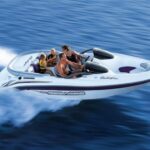
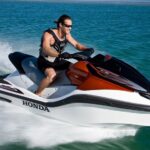
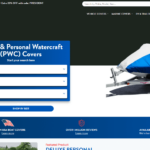
![Amel Sailboat Review [50, 60, Super Maramu, Kirk] amel sailboats](https://boatinggeeks.com/wp-content/uploads/2021/06/amel-sailboats-150x150.jpg)
![Freedom Boat Club Cost [Freedom Membership Cost and Review] freedom boat club cost](https://boatinggeeks.com/wp-content/uploads/2021/07/freedom-boat-club-cost-150x150.jpg)
![Read more about the article How Much Is a Jet Ski? [New and Used Jet Ski Prices]](https://boatinggeeks.com/wp-content/uploads/2021/08/how-much-is-a-jet-ski-300x200.jpg)
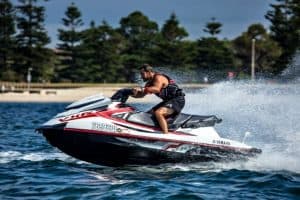
![Read more about the article Polaris Jet Ski Models [Review of Polaris 650, 750, 785, Freedom, Genisis, Mirage]](https://boatinggeeks.com/wp-content/uploads/2021/03/Polaris-jet-ski-300x200.jpg)